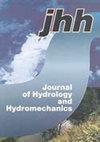Multi-criteria evaluation for parameter uncertainty assessment and ensemble runoff forecasting in a snow-dominated basin
IF 2.4
4区 环境科学与生态学
Q3 WATER RESOURCES
引用次数: 0
Abstract
Abstract The increase in global temperatures undesirably affects the ever-growing world population and reveals the significance of hydrology science. Hydrological models might estimate spatial and temporal variability in hydrological components at the basin scale, which is critical for efficient water resource management. Satellite data sets with enhanced snow mapping with high spatial and temporal resolutions have been developed. The potential of these satellite data sets is evaluated in this study for multi-criteria evaluation of a conceptual hydrological model to improve model performance and reduce uncertainty. The upstream part of the transboundary Coruh River is selected for this study because snowmelt contributes a significant portion of the streamflow feeding major reservoirs during the spring and early summer months. The region’s snow cover dynamic has been analyzed using a combination of two satellite products. Hydrologic modeling is performed using the HBV model for the 2003–2015 water years (01 Oct–30 Sep). The Monte Carlo method is used for multi-criteria optimization exploiting satellite snow cover data besides runoff data. The sensitivity and uncertainty analysis on the model parameters indicate that multi-criteria calibration effectively reduces the uncertainty of the parameters and increases the model performance. Moreover, ensemble runoff forecasts are generated with several best model parameters using 1-day and 2-day lead time numerical weather prediction data for the snowmelt period (March–June) of the 2015 water year. The results indicate that the use of multiple remote sensing products in combination better represents the snow-covered area for the region. Additionally, including these data sets into hydrological models enhances the representation of hydrological components while reducing runoff prediction uncertainty.多准则评价参数不确定性评价及积雪流域综合径流预报
摘要全球气温的升高对不断增长的世界人口产生了不希望的影响,并揭示了水文科学的重要性。水文模型可以估计流域尺度上水文成分的空间和时间变化,这对有效的水资源管理至关重要。已经开发了具有高空间和时间分辨率的增强雪测绘的卫星数据集。本研究评估了这些卫星数据集对概念水文模型进行多标准评估的潜力,以提高模型性能并减少不确定性。本研究选择了跨界科鲁赫河的上游部分,因为融雪在春季和初夏为主要水库提供了很大一部分流量。该地区的积雪动态已经使用两种卫星产品的组合进行了分析。水文建模是使用2003–2015水年度(10月1日至9月30日)的HBV模型进行的。采用蒙特卡罗方法对除径流数据外的卫星积雪数据进行多准则优化。对模型参数的灵敏度和不确定性分析表明,多准则标定有效地降低了参数的不确定性,提高了模型性能。此外,使用2015水年融雪期(3月至6月)的1天和2天提前期数值天气预测数据,使用几个最佳模型参数生成综合径流预测。结果表明,多种遥感产品的组合使用更好地代表了该地区的积雪面积。此外,将这些数据集纳入水文模型可以增强水文成分的代表性,同时减少径流预测的不确定性。
本文章由计算机程序翻译,如有差异,请以英文原文为准。
求助全文
约1分钟内获得全文
求助全文
来源期刊
CiteScore
4.20
自引率
5.30%
发文量
30
审稿时长
>12 weeks
期刊介绍:
JOURNAL OF HYDROLOGY AND HYDROMECHANICS is an international open access journal for the basic disciplines of water sciences. The scope of hydrology is limited to biohydrology, catchment hydrology and vadose zone hydrology, primarily of temperate zone. The hydromechanics covers theoretical, experimental and computational hydraulics and fluid mechanics in various fields, two- and multiphase flows, including non-Newtonian flow, and new frontiers in hydraulics. The journal is published quarterly in English. The types of contribution include: research and review articles, short communications and technical notes. The articles have been thoroughly peer reviewed by international specialists and promoted to researchers working in the same field.

 求助内容:
求助内容: 应助结果提醒方式:
应助结果提醒方式:


